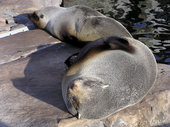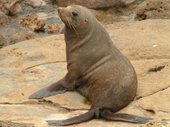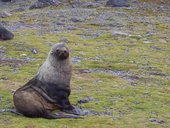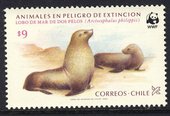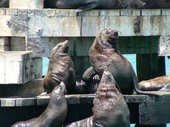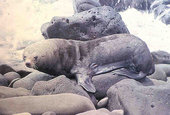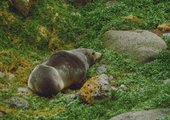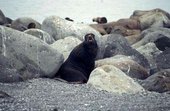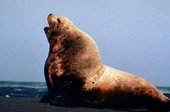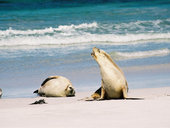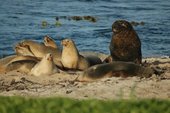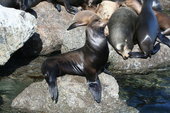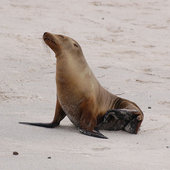Eared Seals
Eared Seals (scientific name: Otariidae) are a family of sixteen species of marine mammals which include sea lions and fur seals. Together with the families of true seals and walruses, Eared seals form the group of marine mammals known as pinnipeds..
Contents
Physical Description
Eared seals differ from true seals in that they have small external earflaps and hind flippers that can be turned to face forwards. Together with strong front flippers, this gives them extra mobility on land and an adult fur seal can move extremely fast across the beach if it has to. They also use their front flippers for swimming, whereas true seals use their hind flippers.
|
Scientific Classification Kingdom: Anamalia (Animals) |
Eared seals show a considerable size difference between the sexes. The males are considerably larger than the female; in some instances, up to five times as large. This makes them among the most sexually dimorphous mammals.
Sea lions differ from fur seal in that theyhave coarse, short fur in contrast to adense underfur characteristic of fur seal. Sea lions are also generallylarger than fur seals. The Galapagos fur seal is the smallest species of eared seal and the Steller Sea Lion is the largest.
Eared Seal Species
There are sixteen species of Eared seals in seven genera:
- Arctocephalus (Southern fur seals) 1. South American fur seal (Arctocephalusaustralis) 2. New Zealand fur seal (also Antipodean fur seal, Australasian fur seal, Black fur seal, and South Australian fur seal.) (Arctocephalusforsteri) 3. Galapagos fur seal (Arctocephalusgalapagoensis) 4. Antarctic fur seal (also Kerguelen fur seal) (Arctocephalusgazella) 5. Juan Fernandez fur seal (Arctocephalusphilippii) 6. South African fur seal (also Cape fur seal, Australian fur seal, Brown fur seal, Giant fur seal, Tasmanian fur seal, and Afro-Australian Fur Seal) (Arctocephaluspusillus) 7. Guadalupe fur seal (also Lower californian fur seal) (Arctocephalustownsendi) 8. Subantarctic fur seal (also Amsterdam fur seal) (Arctocephalustropicalis)
- Callorhinus (Northern fur seal) 9. Pribilof fur seal (also Northern fur seal and Alaska fur seal) (Callorhinus ursinus)
- Eumetopias 10. Steller sea lion (also Northern sea lion, Sea king, Stellar sea lion, and Steller's sea lion) (Eumetopias jubatus)
- Neophoca 11. Australian sea lion (also White-capped sea lion) (Neophoca cinerea)
- Otaria 12. South American sea lion (also Southern Sea Lion,Patagonian Sea Lion, andManed sea lion.(Otaria flavescens)
- Phocarctos 13. New Zealand sea lion (Phocarctos hookeri)
- Zalophus 14. California sea lion (Zalophus californianus) 15. Japanese sea lion (Zalophus japonicus) 16. Galapagos sea lion (Zalophus wollebaeki)
Reproduction
Eared seals are polygynous, meaning that males will establish territories (often created and protected through fighting or shows of aggression) within which they establish a harem and breed witha number of females (the range varies with species). Males will come ashore and establish their territories at the beginning of the mating season.
Most eared seals mate annually at certain times of the year. The Australian sea lion is an exception to this with a breeding cycle of 17.6 months. Females typically arrive a few weeks after the males and select their mates for the coming season. Before mating, the females will first give birth to a pup conceived during the mating season of the prior year. Mating occurs typically 6-12 days after the birth of the pup.
The fertilized egg within the female fur seal undergoes a three to four month period of delayed implantation. This ensures that that the developing pup will be born at the right time the following year when the animals return to their breeding grounds. For the Australian sea lionthe period of delayed implantation may be longer reflecting the longer duration of its breeding cycle.
Distribution
Fur seals are primarily found in the southern hemisphere.Twospecies, the Pribilof fur seal and Guadalupe fur seal,are found in the northern hemisphere,and a third, the Galapagos fur seal, is found on the equator.Sea lions are more broadly distributed.
|
Coast of South America from southern Peru to Southern Brazil, Falkland Islands, South Georgia | |
| South Island, New Zealand, the Bounty Islands,the coast of southwestern Australia | |
| Galapagos Islands | |
|
Seasonally ice-free islands south of the convergence in theSouthern Ocean | |
|
Juan Fernandez Islands off the coast of Chile | |
|
Coast of Namibia and western/southern South Africa, southwest coast of Australia | |
|
Isla de Guadalupe, off the coast of Baja California, Mexico (breeding, non-breedinf observe farther south and north) | |
|
Islands just north of the convergence/Southern Ocean | |
|
Northern Pacific Ocean withmain breeding groundson the Pribilof Islandsin Bering Sea | |
|
North Pacific coasts from the Sea of Japanto California | |
| Islands offshore of western/southern Australia | |
| South American coast from Rio de Janeiroon the Atlanticside and coastal Perú on the Pacific coast | |
| New Zealand's subantarctic islands, in particular Dundas Island in the Auckland Islands | |
|
Pacific coast of North Americafrom British Columbia, Canada south to Baja, Mexico | |
| formerly northwest Pacific,along the coasts of Japan, the Korean peninsula, andSakhalin Island | |
| Galápagos Islands |
Conservation Status
Six eared seal species are included in the IUCN Red List of Threatened Species, four of those, the Galapagos fur seal, Steller Sea Lion, Australian sea lion, and Galápagos sea lion are listed as Endangered (IUCN Red List Criteria for Critically Endangered). One species, the Japanese sea lion, is believed to have gone extinct in the 1950s.
| Least Concern | |
| Least Concern | |
| Endangered | |
| Least Concern | |
| Near Threatened | |
| Least Concern | |
| Near Threatened | |
| Least Concern | |
| Vulnerable | |
| Endangered | |
| Endangered | |
| Least Concern | |
| Vulnerable | |
| Least Concern | |
| Extinct | |
| Endangered |
Further Reading
- Encyclopedia of Life (accessed April11,2009)
- WoRMS, World Registry of Marine Species (accessed March 28, 2009)
- IUCN Red List (accessed April 2, 2009)
- Zalophus japonicus Aurioles, D. & Trillmich, F., 2008, IUCN (accessed April 8, 2009)
- Zalophus, Seal Conservation Society (accessed April 8, 2009)
- MarineBio.org (accessed, April 8, 2009)
- Galápagos and Californian sea lions are separate species: Genetic analysis of the genus Zalophus and its implications for conservation management, Wolf, JB; Tautz, D; Trillmich, F, Frontiers in zoology,2007.
- Archaeology and holocene sand dune stratigraphy on Chatham Island, B. G. McFadgen, Journal of the Royal Society of New Zealand,1994.
- The Pinnipeds: Seals, Sea Lions, and Walruses, Marianne Riedman, University of California Press, 1991 ISBN: 0520064984
- Encyclopedia of Marine Mammals, Bernd Wursig, Academic Press, 2002 ISBN: 0125513402
- Marine Mammal Research: Conservation beyond Crisis, edited by John E. Reynolds III, William F. Perrin, Randall R. Reeves, Suzanne Montgomery and Timothy J. Ragen, Johns Hopkins University Press, 2005 ISBN: 0801882559
- Walker's Mammals of the World, Ronald M. Nowak, Johns Hopkins University Press, 1999 ISBN: 0801857899
